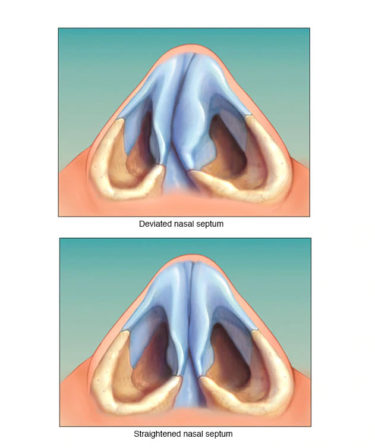 A deviated septum is when the thin divider between your nasal passages is off-center resulting in one passage being smaller than the other. If a deviated septum is slight – most people do not notice any negative effects. However, if severe, one side of your nose could be totally blocked resulting in limited air flow.
A deviated septum is when the thin divider between your nasal passages is off-center resulting in one passage being smaller than the other. If a deviated septum is slight – most people do not notice any negative effects. However, if severe, one side of your nose could be totally blocked resulting in limited air flow.
Symptoms associated with a severe deviated septum include, but not limited to, constant congestion, facial pain, sinus pressure, dry mouth, nose bleeds, snoring, and sleep disturbances.
The causes of a deviated septum are:
- Fetal development.
- Nose injury/trauma such as due to an auto accident or rough contact sports such as football or wrestling.
- The normal aging progression can also affect the structure of the nose; thereby worsening a minor non-noticeable deviated septum.
- Swelling and/or irritation of the sinus or nasal cavities can aggravate and increase the narrowing of nasal passages due from a slight deviated septum.
Treatment
Various types of medication ca help reduce nasal swelling to improve breathing; however, only surgery can correct a deviated septum. This type of surgery is called “Septoplasty”.
What to expect during deviated septum surgery
An ear, nose, and throat (ENT) specialist or a plastic surgeon can perform a Septoplasty. This procedure takes a minimum of 90 minutes and the patient will be under full sedation. The surgeon needs to trim the septum to straighten it out. In more severe situation, the surgeon may need to cut and remove parts of your septum and then reinserts them in the straight position.
In some cases, the septum may need to be supported – if that is the case silicone splits may be necessary. The skin on the face will not need to be cut. Nasal packaging may also be required to absorb fluid and excess blood. This gauze-like material that is placed inside the nasal cavity will be removed at the follow-up appointment. Once removed, saline nasal washes are recommended to keep the nasal passages clean, moist, and free of bacteria.
In some cases, Rhinoplasty (reshaping and/or resizing of the nose) is performed at the same time as the Septoplasty.
Results
The level of improvement after surgery is a direct result of the severity of the condition. For instance, nasal obstructions can be eliminated after having deviated septum surgery. Continuous sinus conditions that have damaged the lining of the nasal tissue may not be completely cured by deviated septum surgery alone.
Recovery and Home Care
Swelling around your nose, eyes, lips, and cheeks is normal after nasal surgery. Some bruising and soreness are also normal for the first few days following the procedure. The sense of smell should return to normal within a couple of months. Ice, wrapped in a cloth, gently applied to the nose several times a day for 10-minute intervals will help reduce swelling and numb any pain.
Also, sleep with your head raised above the rest of your body. Depending on your career, returning to normal activities should resume within 4 to 6 weeks of surgery. Follow-up visitations with the doctor is important.
We perform Rhinoplasty and Septoplasty in our Miami offices, but offer these services all over the country. Virtual consults available.